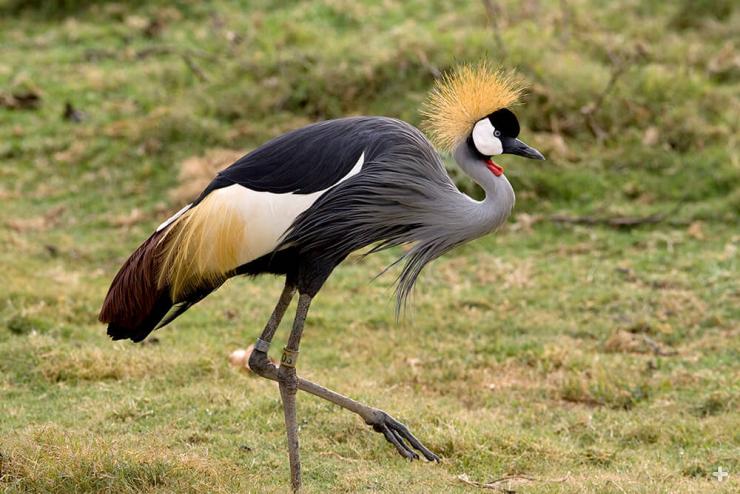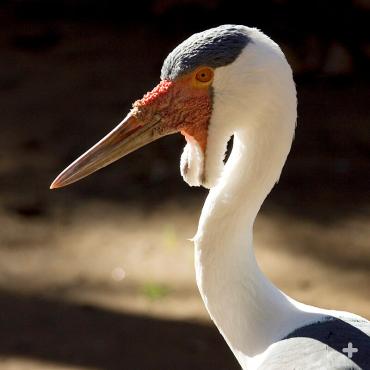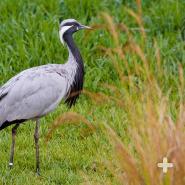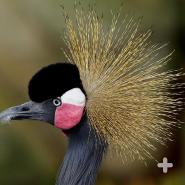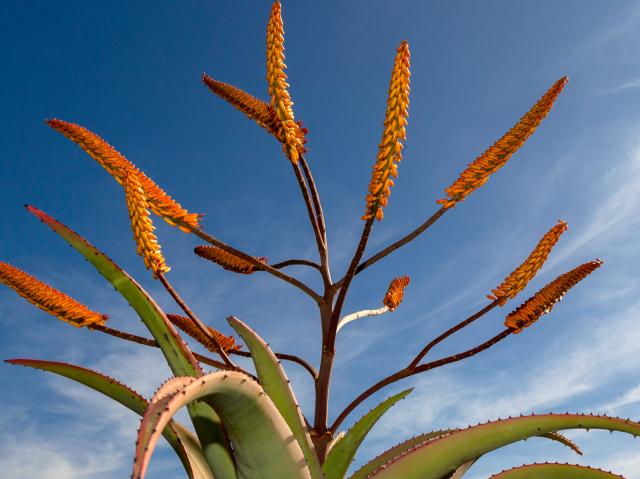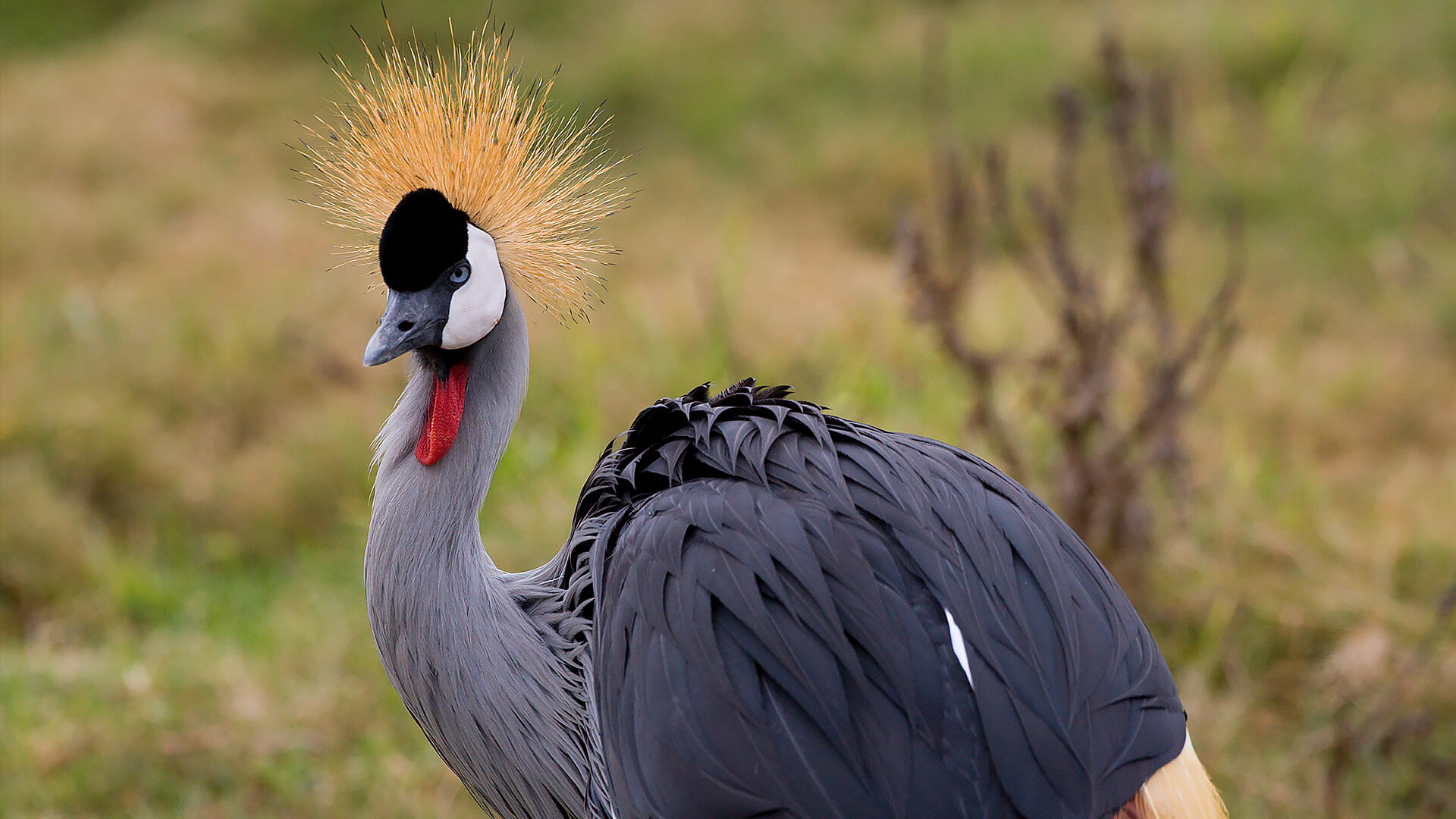
Crane

- Class: Aves (Birds)
- Order: Gruiformes
- Family: Gruidae
- Genera: Balearica, Anthropoides, Bugeranus, Grus
- Species: 15

ABOUT
Regal symbols. From their powerful calls to their intricate dances, cranes have enchanted people for centuries. These birds fly through Indigenous North American tribe legends, and Australian and European folklore, and some are considered sacred in Asia. Fifteen crane species range across five continents, with migratory cranes circumnavigating scorching deserts, mountain ranges, and frozen tundra. Because their migration routes defy the borders of nations, cranes are emblematic of peace and unity among diverse peoples.
Cranes are large birds with a long neck and legs, a streamlined body, and long, rounded wings. Their size and graceful proportions make them easy to recognize by all. Cranes are some of the tallest birds in the world. In flight, their body forms a straight line from bill to toes, presenting a beautiful, elegant image.
Cranes come with a broad array of adornments from ornamental wattles and crests to dramatic plumage colors. The blue crane even puffs out its feathers like a cobra when excited!
On a wing and a prayer. Some cranes are migratory, and some of their migrations are of epic proportions in terms of distance and altitude. Once the average altitude of about 6,500 feet (2,000 meters) is gained, cranes assume a V-formation and glide, calling to each other constantly. Whooping cranes have been known to fly as far as 500 miles (800 kilometers) in a day, although about 186 miles (300 kilometers) is the average.
The highest-flying award goes to Eurasian cranes, flying over the Himalayas at altitudes up to 32,800 feet (10,000 meters)—that’s cruising altitude for jetliners! Meanwhile, some of the smaller demoiselle cranes navigate through the passes of the Himalayas in their migration, while others fly across the vast deserts of the Middle East and northern Africa. The lesser sandhill crane wins the distance award for the longest migration, flying from eastern Siberia across the Bering Sea into North America, sometimes as far south as northern Mexico.
Cranes use a slow, downward flap and a rapid upstroke. They fly with their neck outstretched and their feet straight out behind. Young cranes learn the migratory routes from older birds.
Language school. These remarkable birds also have a vast vocal communication system. Each type has its own tone and volume, from the soft honks of crowned cranes to the flutelike call of Siberian cranes. Crane chicks start to learn their “language” as soon as they hatch and know at least six calls by the end of their first year. By this time their voice has also deepened, becoming louder and stronger.
Cranes have a specialized windpipe—reaching a whopping 5 feet (1.5 meters) in length in the whooping crane—coiled within a hollow sternum to give the calls long-distance capabilities. The call of a whooping crane can often be heard from a mile away.
HABITAT AND DIET
Crane life. These birds use wetlands and grasslands in North America, Africa, Europe, Asia, and Australia.
Some serious yum. Cranes are omnivores that eat everything from snails to acorns to insects to snakes. They readily change their eating habits to take advantage of whatever is available. Anatomy plays a part in what a crane prefers to feed on. Cranes with shorter bills, such as black-crowned cranes, eat insects as well as grasses. Those with long bills, such as brolgas or Australian cranes, probe in shallow wetlands for crustaceans and other aquatic life. The bigger cranes have large, powerful bills and dig up roots and tubers out of the muddy wetlands.
Cranes at the San Diego Zoo Safari Park eat a specialized crane feed, greens, and mealworm larvae.
FAMILY LIFE
Dancing crane. All cranes, young and old alike, participate in elaborate, enthusiastic "dancing," often just for the fun of it! For the young, dancing helps to develop physical and social skills. It serves as a courtship ritual for the single adults and gets established pairs ready to breed, too. In a flock of cranes, once a dance starts, it can quickly become contagious, with all the cranes joining in.
Although dance patterns differ among crane varieties, all have long, detailed sequences of coordinated bows, leaps, runs, and short flights. During a dance, the cranes pick up sticks, grass, feathers, or whatever small objects are near, tossing them up into the air with their bill. The dance of the demoiselle crane has even been described as an avian ballet.
Crane 101. Cranes are highly social birds, usually pairing for life and living in flocks that can be quite large. Of course, living so close together can give rise to disagreements, so cranes need good communication skills. Like flamingos, they deal with their issues using body language common to all cranes. There is recorded evidence of at least 90 different types of these elaborate visual displays. Here's what some of them mean:
Aggressive— The crane stands tall with body feathers smooth and head features expanded. Then it walks stiffly, followed by wing flapping, ruffles, bows, false preening, stomps, nasal snorts, and growls.
Submissive— The crane lowers its head and head feathers and walks in a loose and wary way.
Crouch Threat— The crane bends its legs, lowers to the ground, folds its wings loosely against its body and the ground, and places its head forward with the red patch prominent.
Ruffle Threat— The crane raises the feathers of its neck, wings, and back, partially opens and lowers its wings, ruffles them alternately, then lowers its bill in a preening movement, finishing with a low growl.
Charge— The crane points its neck and head straight down and lifts the feathers along its neck and back, holding the stance for several seconds.
Egging them on. Adult female cranes can lay up to four eggs in a clutch, but two eggs are more common. Eggs laid in warmer climates are white or light-colored to help the eggs reflect excess heat. Eggs laid in colder regions are darker in color so the eggs can absorb heat. While some only raise one chick, others raise two. Since one chick will always become dominant, the weaker chick often dies if food is scarce.
It was a common belief that cranes keep the same mate their entire life, but recent scientific research indicates that this is not the case. However, once the nest is built and the eggs are laid, both parents help raise the young.
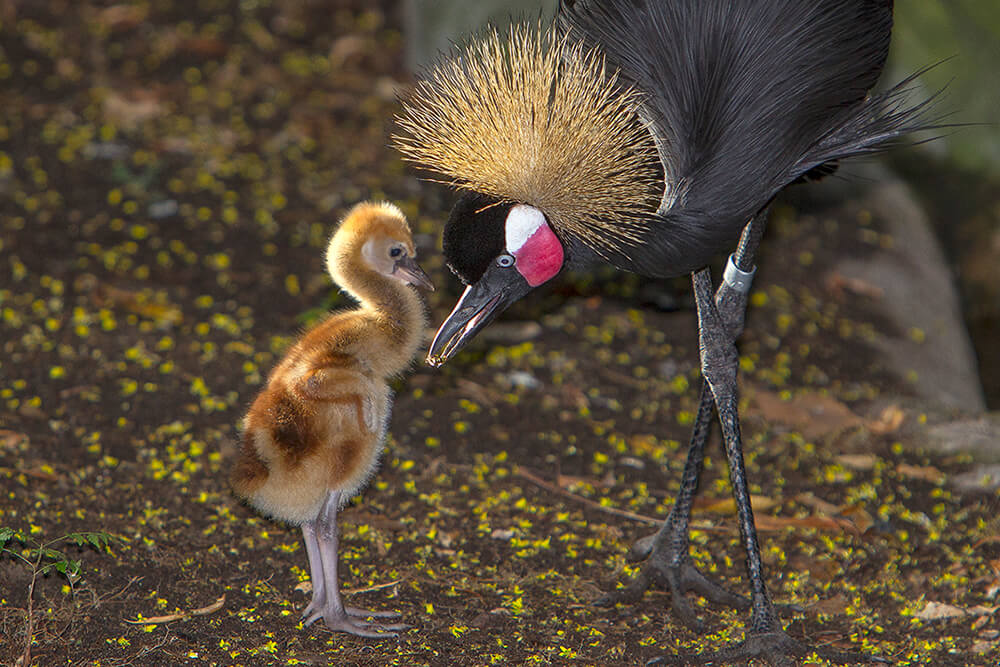
Social and precocial. Crane chicks are precocial, and parents begin feeding them almost immediately after they hatch. Chicks are mostly a light brown, with a few cranes being silver gray. These colors provide camouflage against predators. The chicks grow very, very quickly and soon learn to follow their parents to food sources. Sometimes, adults feed chicks until they are several months old.
The youngsters develop their flight feathers at two to four months of age, preparing them for long migrations. During their second year, adult feathers gradually replace the juvenile plumage.
SaveSave
CONSERVATION
Cranes in trouble. All crane populations are rapidly dwindling. The Siberian crane Grus leucogeranus is at critical risk, due mainly to hunters shooting them during their 4,000-mile migration between the Russian arctic and India. The red-crowned crane Grus japonensis is endangered mainly due to loss of habitat; cranes need large areas of habitat, which are gradually being turned into farms or housing sites. Even the marshes where cranes nest are being slowly drained for agricultural purposes. The gray-crowned crane Balearic regulorum is endangered due to the illegal trade.
Back from the brink. Whooping cranes Grus americana are the tallest birds in North America. They were once numerous in the prairie wetlands of the US and Canada, but settlers drained the wetlands to build farms and cities, and hunted the large birds for their meat. By 1941, only 15 birds were observed at their wintering area on the Gulf Coast of Texas. To help save the birds, refuges were established, the birds were carefully monitored, and hunters were educated about the harm they could do to the population.
Through intensive efforts, there are now two distinct migratory populations—the only natural, self-sustaining whooping crane flocks left in the world. There are also small, nonmigratory flocks of whooping cranes in Florida and Louisiana. Whooping cranes are still endangered, but there is certainly more hope for the birds these days, with their numbers currently at almost 600 birds in managed care and the wilderness.
Helping cranes. In 1973, the International Crane Foundation was founded to be the world center for the study and preservation of cranes. It has become a world leader in crane conservation, including the breeding of endangered cranes. San Diego Zoo Wildlife Alliance works with the Foundation, providing cranes for breeding and helping with wetland conservation work in China. The founder of the International Crane Foundation, George Archibald, Ph.D., is the 2005 San Diego Zoo Wildlife Alliance Conservation Medalist.
San Diego Zoo Wildlife Alliance is dedicated to crane conservation and, in particular, an artificial insemination program involving sarus, red-crowned, demoiselle, and blue cranes.
By supporting San Diego Zoo Wildlife Alliance, you are our ally in saving and protecting wildlife worldwide.
LIFE SPAN
20 to 50 years
YOUNG
Incubation: 28 to 36 days, depending upon the species
Number of eggs: 1 to 4 per clutch
Maturity: 2 years old
SIZE
Tallest: Sarus crane at 5.7 feet (1.76 meters)
Shortest: Demoiselle crane at 3 feet (0.8 meters)
Heaviest: Red-crowned crane at 17 to 25 pounds (7.7 to 11 kilograms)
Lightest: Demoiselle crane at 4 to 7 pounds (1.8 to 3.1 kilograms)
FUN FACTS
Cranes have been clocked flying 45 miles (72 kilometers) per hour.
The sarus crane is the tallest of the cranes and the tallest flying bird.
The white-naped crane is an important symbol in the Korean New Year celebration and is featured in art and folklore.
Queen Marie Antoinette of France gave the dainty demoiselle crane its name. “Demoiselle” means maiden, or young lady, in French. The queen was enchanted by the crane's delicate and maidenly appearance.
Ancient Greeks believed the flight of cranes inspired the god Hermes to invent the Greek alphabet.
Fossil records show that crowned cranes existed 37 to 54 million years ago. Prehistoric cave paintings of cranes have been found in Europe, Africa, and Australia.
Sandhill crane chicks have been known to start swimming when they are only six hours old.
The flag of Uganda features a crowned crane, making it one of the few national flags to bear the image of a bird.
The mating rituals of crowned cranes are so engaging that some African tribes have made them a part of their culture.
Ancient Egyptians decorated their tombs with images of cranes.
Red-crowned cranes are associated with nobility and immortality in China.
In 2011, people around the world folded paper cranes to help raise money for earthquake and tsunami victims in Japan.
Crowned cranes are the only cranes that roost in trees.
Black-necked cranes were the last crane discovered and described by ornithologists (1876), due to their remoteness in China’s high-altitude wetlands.


